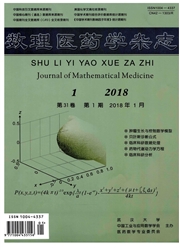

 中文摘要:
中文摘要:
目的:探讨声音刺激与神经元第一发放延时之间的编码关系是否可通过所示方程来更好地表现出来。方法:在4~6周BALB/c小鼠下丘神经元上,采用在体细胞外记录方法,采用不同起始动态特征的纯音包络波对小鼠下丘神经元给予双耳声音刺激,并同时改变声刺激的3个实验控制参数:上升函数、上升时间(分别设为2,5,10,20,50,100 millisecond,ms)和稳态声压(阈值到90 decibel,dB),并记录对应于特定上升函数、上升时间和稳态声压时的第一动作电位发放延时。然后以特定的数理模型对单位神经元数据进行分析处理,以确定声音起始瞬时声压与神经元第一发放延时之间的关系。结果:共记录到70个神经元反应。通过分析发现,推导出来的方程中的时间转换常数(T)和声压指数(K)是预测神经元第一发放延时的重要参数。结论:声音包络波的瞬时声压与小鼠下丘神经元第一发放延时良好的对应关系可通过此方程的两个常数预测出来。
 英文摘要:
英文摘要:
Objective. To explore the relationship between sound stimulus and first spike latency of neuronal response and whether or not the relationship could he represented better through our fitting equation. Methods: With 4 to 6 weeks BALB/c mouse, we employed extracellular recording technique on their central nuclei of inferior eolliculus. The three experimentally controlled parameters of sound stimulus were changed simultaneously, with rise time set as 2, 5, 10, 20, 50, 100 ms separately, sound pressure upmost to 90 dB. Then the first spike latency of auditory neurons were recorded through our software (BrainWare of TDT). Binaural stimulus to inferior colliculus of mouse was performed. The pure tone envelope of sound with different dynamic features was employed. The single-unit data was processed by our unique mathematical method. Results: A total of 70 single unit responses of neurons was gotten. And we found time transmitting constant (T) and sound pressure index (K) derived from our presented equation are more suitable to predicting the relationship between instantaneous pressure of sound envelope and first spike latency of neuronal response. Conclusion: The relationship between sound stimulus and first spike latency of neurons can be predicted by two constants of our presented equation.
 同期刊论文项目
同期刊论文项目
 同项目期刊论文
同项目期刊论文
 B ilateral cortical interaction: modulation of delay-tuned neurons in the contralateral auditory cor
B ilateral cortical interaction: modulation of delay-tuned neurons in the contralateral auditory cor First spike latency and spike count as functions of tone amplitude and frequency in the inferior col
First spike latency and spike count as functions of tone amplitude and frequency in the inferior col Recovery cycle of neurons in the inferior colliculus of the FM bat determined with varied pulse-echo
Recovery cycle of neurons in the inferior colliculus of the FM bat determined with varied pulse-echo 期刊信息
期刊信息
